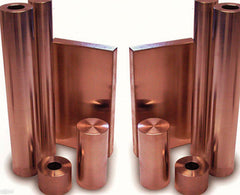From Art to Performance: The Many Applications of One-of-a-kind Copper Products
From Art to Performance: The Many Applications of One-of-a-kind Copper Products
Blog Article
How Copper Products Contribute to Sustainable Practices in Different Industries
Copper items are increasingly identified for their considerable payments to sustainable practices throughout multiple fields, driven by their fundamental homes such as resilience, recyclability, and performance. In sustainable power systems, for instance, copper enhances the performance of solar and wind technologies, while its application in construction reduces waste via longevity. Moreover, the product's antimicrobial qualities offer encouraging advantages in medical care settings. As markets seek to take on more lasting techniques, the function of copper might verify critical in accomplishing environmental goals. What implications might this have for future developments in sustainability?
Copper in Renewable Resource
Copper plays a vital role in the improvement of renewable resource innovations, acting as an essential conductor in various applications. Its remarkable electrical conductivity and resistance to rust make it a perfect material for electrical circuitry, which is crucial in photovoltaic panels, wind generators, and power storage space systems. In solar photovoltaic or pv systems, copper is made use of in the affiliations and circuitry, making it possible for effective energy conversion from sunlight to electrical power.
In wind power, copper is essential to the generators and transformers that convert kinetic energy into electrical energy, guaranteeing ideal performance and integrity. The demand for electric vehicles (EVs) is raising, with copper being a crucial component in batteries, motors, and charging framework. The shift to EVs substantially enhances the demand for copper, as these vehicles commonly make use of 4 times more copper than standard interior combustion engine automobiles.
As the world seeks to alleviate climate adjustment and transition to lasting power sources, copper's function comes to be progressively vital. The material not just enhances the efficiency and resilience of eco-friendly energy systems but likewise sustains the more comprehensive objective of reducing greenhouse gas emissions and promoting a lasting future.
Eco-Friendly Construction Materials
Over the last few years, there has been a significant shift in the direction of the adoption of eco-friendly building and construction products in response to growing environmental problems. This change is inspired by the demand for sustainable choices that minimize eco-friendly footprints while preserving architectural integrity and visual charm.
Copper, understood for its longevity and recyclability, has become a principal in this field. It can be used in roof covering, pipes, and electrical systems, contributing to power efficiency and minimizing waste. Copper's longevity implies fewer substitutes with time, further improving its sustainability account.
In addition, products such as bamboo, reclaimed wood, and recycled steel are getting appeal. These alternatives not only use minimized ecological influence but likewise promote source preservation. As building codes progressively emphasize sustainability, builders and engineers are integrating these materials into their projects, promoting advancement in style.
The increasing fostering of green construction products reflects a broader commitment to sustainability in the built environment. By prioritizing these materials, the building market can dramatically lower its carbon impact, align with regulative criteria, and sustain a much healthier community for future generations. This trend marks a pivotal action in the direction of a much more sustainable future in building and construction.
Copper's Duty in Medical care
Current research studies have actually highlighted the substantial duty of copper in healthcare settings, especially as a result of its antimicrobial buildings. Copper surface areas have been shown to reduce the existence of microorganisms, including infections and germs, by approximately 99.9% within a short duration. This exceptional efficacy makes copper an invaluable material for high-touch surface areas in health centers, such as doorknobs, bed rails, and IV posts, therefore adding to enhanced infection control measures.
In enhancement to its direct antimicrobial effects, copper content additionally plays a duty in the more comprehensive context of health center sustainability (Copper Products). By including copper right into medical devices and home furnishings, medical care centers can reduce the occurrence of healthcare-associated infections (HAIs), which not only enhances patient end results yet likewise lowers the expenses linked with prolonged medical facility keeps and additional treatments
Furthermore, copper's toughness and recyclability align with sustainable techniques, permitting accountable source administration. As health care systems significantly prioritize both patient security and environmental stewardship, the combination of copper products is click to find out more ending up being more prevalent. This dual benefit underscores copper's vital payment to a much healthier, safer, and extra sustainable health care setting.
Sustainability in Transport

Moreover, copper's durability and corrosion resistance add to the longevity of transportation facilities (Copper Products). In rail systems, for instance, copper elements boost the reliability and efficiency of signaling and power systems, crucial for decreasing delays and energy usage. Furthermore, copper's duty in renewable resource systems, such as solar and wind, supports sustainable transportation services by giving clean energy for electrical transit choices
Investments in copper technology not only foster sustainability however additionally boost economic development and job development in environment-friendly sectors. As sectors strive to meet rigorous ecological regulations, the application of copper items in transportation arises as a critical strategy in accomplishing sustainability goals and advertising a cleaner, extra efficient future.
Copper and Circular Economic Climate
As the world progressively embraces sustainability, the role of copper in the circular economic situation comes to be ever before extra considerable. Copper's innate residential or great site commercial properties-- such as its sturdiness, recyclability, and conductivity-- setting it as a crucial material in a resource-efficient economic situation. The circular economy aims to lessen waste and maximize resource usage with recycling and reusing products, and copper excels in this respect.
The metal can be reused indefinitely without loss of quality, making it an excellent prospect for lasting practices throughout different sectors, consisting of building and construction, electronics, and sustainable energy. By recycling and recovering copper from end-of-life products, sectors can dramatically lower the requirement for virgin materials, consequently lowering environmental impacts linked with mining and handling.
Moreover, the combination of copper right into round economic climate structures not just conserves sources yet likewise cultivates innovation. Services that prioritize copper recycling add to an extra lasting supply chain, improving their competition while aligning with regulatory needs and consumer preferences for eco accountable products.
Verdict
In verdict, copper items substantially contribute to sustainable methods throughout several sectors. Their necessary duty in boosting renewable resource modern technologies, promoting environment-friendly building products, supporting infection control in healthcare, helping with lasting transport, and embodying the principles of a circular economic climate highlights the flexibility and relevance of copper. By incorporating copper right into numerous applications, markets can achieve higher efficiency, reduce environmental influence, and straighten with international sustainability goals, inevitably fostering a more lasting future.

Copper's excellent conductivity makes it a recommended material in electrical vehicle (EV) systems, enhancing power effectiveness and efficiency. Furthermore, copper's duty in sustainable energy systems, such as solar and wind, sustains lasting transport solutions by offering clean power for electrical transportation options.
Their important function in improving renewable energy innovations, advertising green construction materials, supporting infection control in healthcare, helping with lasting transport, and embodying the principles of a round economy highlights the versatility and significance of copper.
Report this page